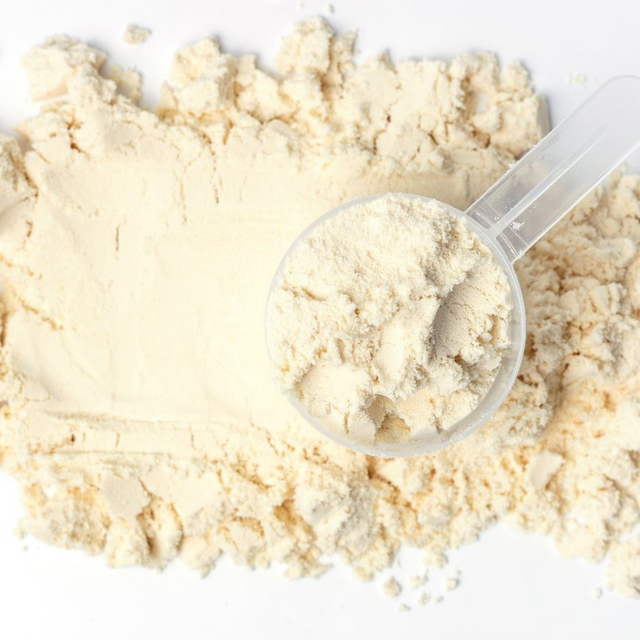What Is Creatine?
Creatine is a combination of three amino acids - methionine, arginine and glycine - that occurs naturally in the liver and kidneys, and is stored in your muscles. About half of the body’s creatine supply is derived from this process and the other half comes from food and diet. Creatine goes on to create adenosine triphosphate (ATP), which is essentially the body’s natural energy source.
When you take a creatine supplement, you’re increasing the amount of creatine stores in your body. This effectively gives you an energy boost, which is why creatine supplements are commonly used by athletes and people who regularly workout. Creatine has a number of physiological benefits, including:
- Improving exercise performance
- Increasing lean body mass
- Increasing strength
- Aiding muscle recovery
Creatine usually comes in a powdered form that is mixed up with water or added to your favourite shake.
Dosage
When it comes to creatine, there are two dosing stages. If you’ve just started taking creatine, you’ll need to begin with a loading dose. This will increase creatine stores in the body which is necessary for the supplement to take effect. When in the loading dose phase, you’ll be taking a higher amount of creatine over a finite time period. A loading dose is usually 20g per day for 2-5 days. You could also decrease the daily dose but extend the number of days in your loading dose phase, for example taking 9g daily for 6 days.
Once you’ve completed your loading dose, you’ll now take a maintenance dose of 2-5g daily. Our Body Science Pure Pharmaceutical Grade Creatine contains 3g per daily dose.
What Is Pre Workout?
Pre workout combines multiple ingredients that work together to improve athletic performance and boost energy levels. Like creatine, pre workout usually comes in a powdered form that mixes with water, which you’ll drink before you workout.
Pre workout helps to:
- Boost energy
- Improve mental focus
- Improve strength
While the formula and ingredients list will vary from product to product, there are a few things to look for when selecting your pre workout supplement.
Avoid Proprietary Blends
A proprietary formula will only list the combined amount of all the ingredients rather than specifying how much of each ingredient is included in the formula. This is a sneaky way of hiding the fact that the product is likely made up of filler ingredients, containing minimal traces of the active ingredients listed.
Avoid These Ingredients
Some pre workouts contain high levels of sugar, artificial sweeteners, and excess caffeine, all of which can result in unwanted gastrointestinal side effects.
Look For These Ingredients
These are the elements you’ll want to see included in your pre workout:
- Beta-Alanine - this ingredient helps to prevent that burning sensation in your muscles by reducing acid build-up, allowing you to push a little harder during those last reps
- Caffeine - caffeine will help to boost energy and improve focus. We recommend a maximum of 100mg per 10g serving of pre workout.
- Branched-chain amino acids (BCAAs) - these acids minimise protein breakdown and aid muscle growth.
- Nitric Oxide Precursors - Specific precursors are L-arginine, L-citrulline, and beetroot juice. These ingredients promote blood flow and improve the flow of oxygen to your muscles.
Some pre workout formulas contain creatine, but the daily dose is usually too small to benefit your workout. If pre workout does include creatine, most formulas only include 1-2g per serving.
This is below the recommended creatine maintenance dose, in which case creatine should be taken in addition to pre workout. But more on that in a bit.
Looking for a pre workout with enough creatine in it?
Body Science K-OS Pre Workout contains 3g of creatine per daily dose, which sits within the maintenance dose range.
Dosage
Unlike creatine, pre workout doesn’t require a loading dose. You can simply take the recommended dose 15-30 minutes before your workout.

What's The Difference Between Pre-Workout and Creatine?
So, we understand that creatine and pre workout can both improve energy, strength and athletic performance. But what’s the difference between pre workout and creatine?
Pre workout ingredients deplete quickly, especially the stimulant components such as caffeine. They’re designed to deliver benefits in the short term, which is why pre workout is designed to be taken just before your gym session. This allows you to maximise the impact of these ingredients while they last.
Creatine operates differently, in that it only works after the creatine stores have been built up over time (hence the loading dose). It also differs from pre workout because there’s no hard and fast rule as to when you should take creatine. You have a few options:
- Pre-Workout - Taking creatine before your workout means you’re maximising that creatine energy rush.
- Post Workout - Creatine can aid muscle recovery, so your supplement post-workout can help to heal your muscles and prevent injuries. Your creatine stores will also be depleted post-workout, so taking a dose afterwards can help to top them up again before your next workout.
- Pre and Post Workout - Some experts argue that by splitting your daily creatine dose in two, you’re receiving the best that creatine has to offer. You’re improving your athletic performance and aiding your recovery.
Does Creatine Work As A Pre Workout?
So, with this in mind, is creatine a pre workout? Creatine can definitely be taken on its own before you work out. Remember, creatine only works its magic once you have sufficient stores in your body. Ensure that you’ve completed the loading dose phase for best results if you’re relying on creatine alone to maximise your performance.
Can You Mix Creatine With Pre Workout?
Yes, you can absolutely mix creatine with pre workout, and many experts say you should! If your pre workout formula doesn’t contain any creatine, it’s a great idea to take your creatine dose alongside your pre workout drink. You’ll be drawing from both the energy-inducing pre workout elements as well as your topped up creatine stores. That means more energy, increased mental focus, and increased strength capabilities - a dream combination.
Key Takeaways
- Creatine occurs naturally in the body and some foods, but can also be taken in supplement form.
- Creatine stimulates the body’s ATP which increases energy, strength, and lean body mass, as well as aiding muscle recovery.
- Pre workout contains a myriad of ingredients that work together to improve athletic performance and boost energy.
- Pre workout needs to be taken just before a workout because the impacts are short-lived and short-lasting.
- Creatine needs to be built up in the body over time for the benefits to take effect, and can be taken either pre workout, post workout or both pre and post workout.
- Creatine can be used on its own as a pre workout supplement if desired.
- Creatine and pre workout can and, in some cases, should be mixed together to maximise performance, strength and energy levels.
More stories

Using Whey Protein for Weight Loss
